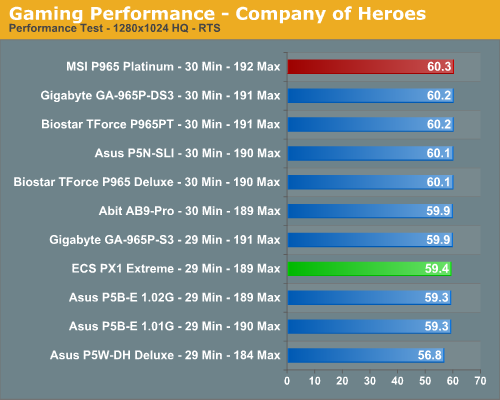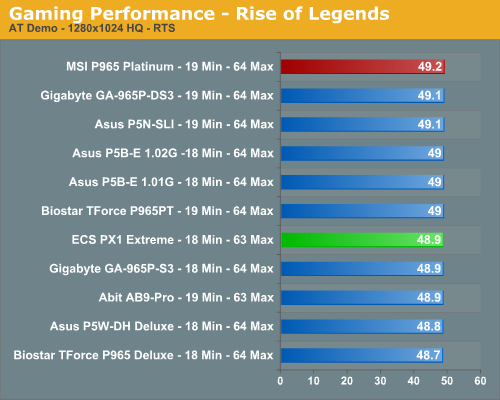Intel P965: MSI P965 Platinum and ECS PX1 Extreme
by Gary Key on December 6, 2006 4:30 AM EST- Posted in
- Motherboards
Gaming Performance - RTS
While our previous tests were based around First Person Shooters we are going to take a look at how our motherboards perform with Real Time Strategy games.
Company of Heroes
Company of Heroes has proved itself to be a very addictive RTS game around the office, and it is arguably one of the best games released during the past year. This game is very GPU intensive and also requires a hefty CPU at times. The game contains a built-in performance test that utilizes the game engine to generate several different action scenes along with a coffee argument as a sideline distraction before the war starts. We found the performance test gives a good indication of how well your system will perform throughout the game on average. Some of the in-game action sequences are more demanding than the performance test, but we generally found the game to be enjoyable with an average performance test frame rate above 35fps.

Rise of Legends
This game was released backing the first half of 2006 and like most real time strategy games is very CPU intensive, but it offers a very visual experience as well. In order to experience the game properly you need a fast CPU, very good memory subsystem, and a decent GPU to play at the higher resolutions. We utilize FRAPS to capture the results from our replay file. Our benchmark consists of a one on one match-up that takes approximately an hour to complete with some significant action throughout the game. Our camera movements are constant as we try to out play each other with a general tank rush between the two Vinci sides every few minutes. We set all video options to high but disable AA (although we found it makes very little difference in the performance of the game at the lower resolutions). We generally found the game to be enjoyable with an average frame rate above 35fps.

RTS Gaming Summary
Our results follow the FPS benchmark scores with all of the P965 boards scoring very close to each other. We still see the 975X trailing the other boards but our ASUS 570SLI is suddenly competitive with the P965 offerings. Once again, the MSI P965 Platinum motherboard is the winner and overtakes our previous champ the Gigabyte GA-P965-DS3. We spent numerous hours testing each game in single player and online multiplayer modes with the audio system enabled. We did not note any issues during our game play experiences at stock or overclocked settings with the latest BIOS releases installed.
While our previous tests were based around First Person Shooters we are going to take a look at how our motherboards perform with Real Time Strategy games.
Company of Heroes
Company of Heroes has proved itself to be a very addictive RTS game around the office, and it is arguably one of the best games released during the past year. This game is very GPU intensive and also requires a hefty CPU at times. The game contains a built-in performance test that utilizes the game engine to generate several different action scenes along with a coffee argument as a sideline distraction before the war starts. We found the performance test gives a good indication of how well your system will perform throughout the game on average. Some of the in-game action sequences are more demanding than the performance test, but we generally found the game to be enjoyable with an average performance test frame rate above 35fps.

Rise of Legends
This game was released backing the first half of 2006 and like most real time strategy games is very CPU intensive, but it offers a very visual experience as well. In order to experience the game properly you need a fast CPU, very good memory subsystem, and a decent GPU to play at the higher resolutions. We utilize FRAPS to capture the results from our replay file. Our benchmark consists of a one on one match-up that takes approximately an hour to complete with some significant action throughout the game. Our camera movements are constant as we try to out play each other with a general tank rush between the two Vinci sides every few minutes. We set all video options to high but disable AA (although we found it makes very little difference in the performance of the game at the lower resolutions). We generally found the game to be enjoyable with an average frame rate above 35fps.

RTS Gaming Summary
Our results follow the FPS benchmark scores with all of the P965 boards scoring very close to each other. We still see the 975X trailing the other boards but our ASUS 570SLI is suddenly competitive with the P965 offerings. Once again, the MSI P965 Platinum motherboard is the winner and overtakes our previous champ the Gigabyte GA-P965-DS3. We spent numerous hours testing each game in single player and online multiplayer modes with the audio system enabled. We did not note any issues during our game play experiences at stock or overclocked settings with the latest BIOS releases installed.










13 Comments
View All Comments
mostlyprudent - Wednesday, December 6, 2006 - link
I had been looking forward to the review of the MSI board. I can understand some OC limitation at the price, but then don't call it a "Platinum" board. I really don't do very much OCing, but always view the ability to reach high overclocks as a sign of a more well engineered board.Anyway, thanks for the review.
Beachspree - Monday, December 11, 2006 - link
I was wondering why the Firewire performance is so poor in these reviews:Firewire 400 gets a best throughput of 230.6Mb/s
It is known that Macs have poor USB 2 performance but look at the Firewire results by Barefeats:
http://www.barefeats.com/usb2.html">http://www.barefeats.com/usb2.html
http://www.barefeats.com/hard70.html">http://www.barefeats.com/hard70.html
Without the perfect conditions of a RAM disk and no cacheing they get real world performance of up to:
Firewire 400: 304 Mb/s (31% faster)
Firewire 800: 464 Mb/s (41% faster)
For comparison, Macs are getting lousy USB 2 performance. Intel Macs have improved it but that takes it from around 136Mb/s to 168Mb/s. That's 75% slower.
Given the importance of Firewire in critical multimedia applications and it's likely use for HD video camcorders does this poor performance not warrant a mention?
Beachspree - Monday, December 11, 2006 - link
To be clearer:Can we please have some real world figures for USB 2.0, eSATA and Firewire 400/800 transfers?
That should take the form of transfers of:
a) Many small files
b) One large file
under default settings and off an internal 7200 HDD you standardize on. That's what most people actually do when the backup, so that's what we need to see in order to make informed choices. I suspect these data rates you keep publishing are ones we will actually never see.
I suggest, also, that poor Firewire performance in Windows is more important than poor USB on Macs. They always have Firewire built in and tend to it on peripherals, while Windows users often make do with USB until they get into music or video editing when they then find the need for Firewire and hit this poor performance just when they start needing mission critical performance. I'm talking about dropped frames and music latency.
Why is that ignored in all your motherboard reviews?
Thanks.